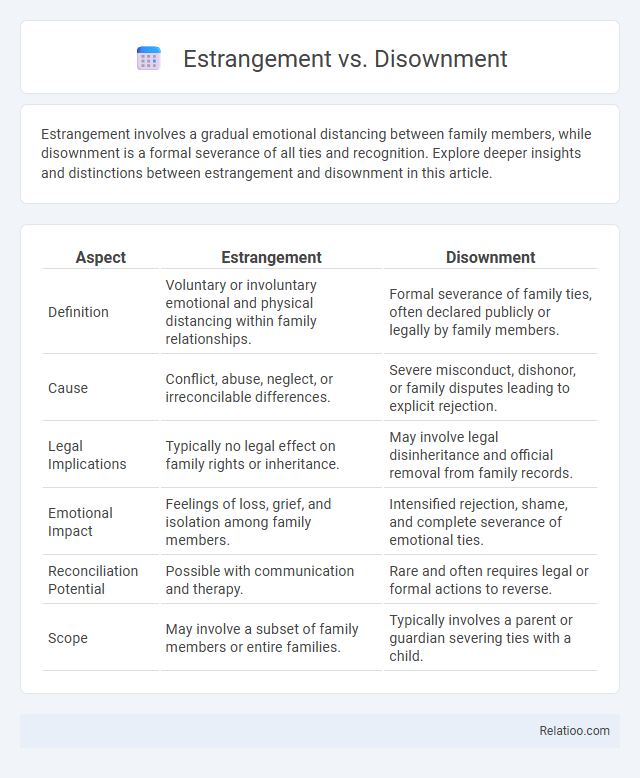Estrangement involves a gradual emotional distancing between family members, while disownment is a formal severance of all ties and recognition. Explore deeper insights and distinctions between estrangement and disownment in this article.
Table of Comparison
| Aspect | Estrangement | Disownment |
|---|---|---|
| Definition | Voluntary or involuntary emotional and physical distancing within family relationships. | Formal severance of family ties, often declared publicly or legally by family members. |
| Cause | Conflict, abuse, neglect, or irreconcilable differences. | Severe misconduct, dishonor, or family disputes leading to explicit rejection. |
| Legal Implications | Typically no legal effect on family rights or inheritance. | May involve legal disinheritance and official removal from family records. |
| Emotional Impact | Feelings of loss, grief, and isolation among family members. | Intensified rejection, shame, and complete severance of emotional ties. |
| Reconciliation Potential | Possible with communication and therapy. | Rare and often requires legal or formal actions to reverse. |
| Scope | May involve a subset of family members or entire families. | Typically involves a parent or guardian severing ties with a child. |
Understanding Estrangement: Definition and Causes
Estrangement refers to the state of emotional separation or alienation between individuals, often within families, characterized by reduced or no communication and a breakdown in the relationship. Causes of estrangement commonly include unresolved conflicts, differing values or beliefs, mental health issues, abuse, or significant life changes that breed resentment and mistrust. Understanding estrangement requires recognizing the complex interplay of these factors that lead to voluntary or involuntary distancing, distinguishing it from disownment, which is a formal and explicit rejection.
What Does Disownment Mean?
Disownment refers to the formal or informal act of rejecting a family member, often severing all legal and emotional ties, unlike estrangement which is a gradual emotional distancing without necessarily cutting off contact. Disownment typically involves explicit communication of rejection, sometimes including removal from wills or family records, making it a definitive and public declaration of severance. Estrangement is more ambiguous, characterized by reduced interaction and unresolved conflicts, whereas disownment is a clear, intentional act of renunciation.
Key Differences Between Estrangement and Disownment
Estrangement involves a gradual distancing or breakdown in a personal relationship without formal severance, while disownment is a deliberate and official repudiation, often documented or publicly declared by family members. The key difference lies in intent and formality: estrangement can occur organically and without explicit acknowledgment, whereas disownment is an explicit act of renunciation, typically carrying legal or social consequences. Understanding these distinctions helps you navigate complex family dynamics and choose appropriate responses based on the relationship status.
Common Reasons for Family Estrangement
Common reasons for family estrangement include unresolved conflicts, differences in values or beliefs, and feelings of betrayal or neglect. Estrangement often occurs gradually through emotional distancing, while disownment is a more explicit and formal rejection by a family member. Understanding these dynamics can help you navigate complex family relationships and work towards potential reconciliation.
Legal and Social Implications of Disownment
Disownment involves a formal legal act where an individual, often a parent, severes all familial ties, potentially affecting inheritance rights and financial responsibilities. Estrangement is typically informal and social, characterized by emotional distance without legal consequences, whereas disownment carries enforceable impacts on wills, estates, and legal obligations. Understanding these distinctions is crucial for managing your family relationships and protecting your legal interests.
Emotional Impact of Estrangement on Individuals
Estrangement causes deep emotional distress characterized by feelings of sadness, loneliness, and loss that profoundly affect individuals' mental health. Unlike disownment, which often involves a formal severance or rejection, estrangement develops gradually and can lead to prolonged periods of unresolved pain and confusion. Understanding the emotional impact of estrangement helps you navigate the complexities of strained family relationships and seek appropriate support.
Navigating Communication During Family Estrangement
Navigating communication during family estrangement requires understanding the distinct dynamics of estrangement, disownment, and reconciliation to set clear boundaries and expectations. Estrangement often involves emotional distance without formal severance, while disownment is a more explicit and permanent repudiation, affecting how you approach conversations and conflict resolution. Tailoring your communication strategy to these nuances helps maintain respect and emotional safety for all parties involved.
Reconciliation: Is It Possible After Disownment?
Estrangement and disownment both involve emotional and physical separation, but disownment is typically more definitive and formal, often resulting in the complete severance of family ties. Reconciliation after disownment is challenging but not impossible, requiring sincere efforts, open communication, and often time to heal deep wounds. Successful reconciliation hinges on mutual willingness to forgive, understand past grievances, and rebuild trust.
Coping Strategies for Estranged or Disowned Individuals
Coping strategies for estranged or disowned individuals include seeking therapy to address emotional trauma and build resilience, establishing supportive social networks that provide understanding and validation, and practicing self-care routines to improve mental and physical well-being. Developing clear personal boundaries and engaging in reflective journaling can also help process feelings and foster forgiveness or acceptance. Joining support groups specifically for estranged or disowned people offers shared experiences and practical advice for navigating complex family dynamics.
Seeking Support: Resources for Affected Families
Seeking support is crucial for families facing estrangement, disownment, or related conflicts, as these situations often involve complex emotional and psychological challenges. Resources such as family therapy, support groups like the Family Estrangement Support Group, and counseling services specializing in family dynamics provide essential tools for communication and healing. Access to online forums and educational materials from organizations like Mental Health America can also empower affected individuals to navigate these difficult relationships effectively.

Infographic: Estrangement vs Disownment
 relatioo.com
relatioo.com